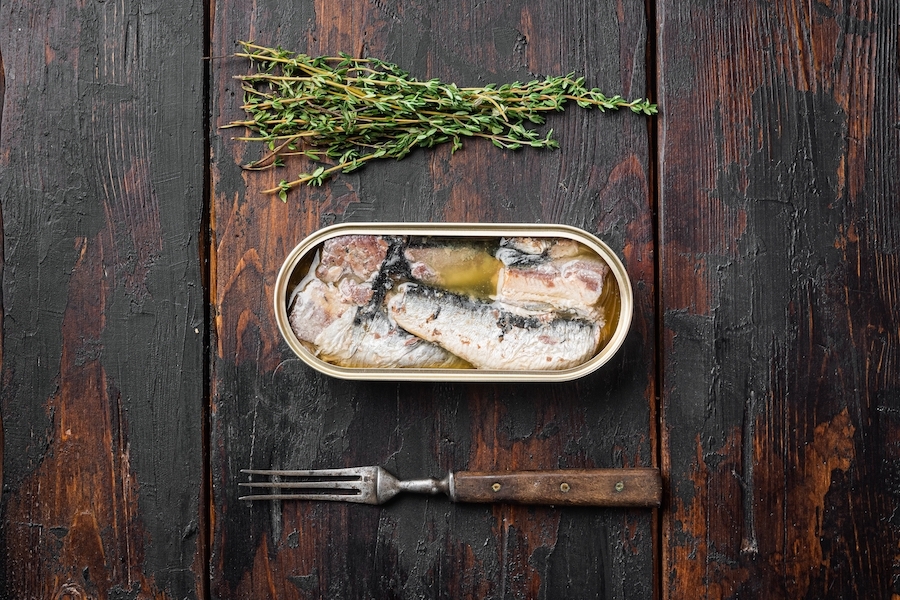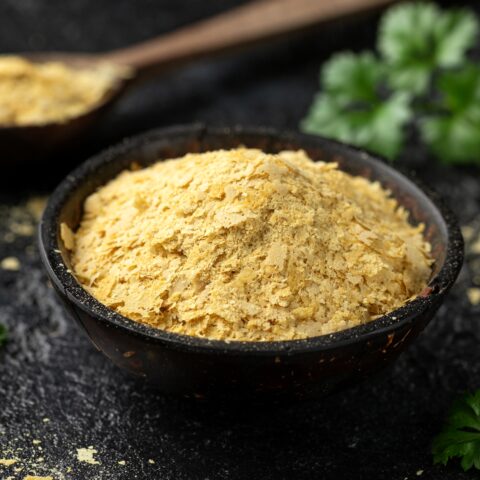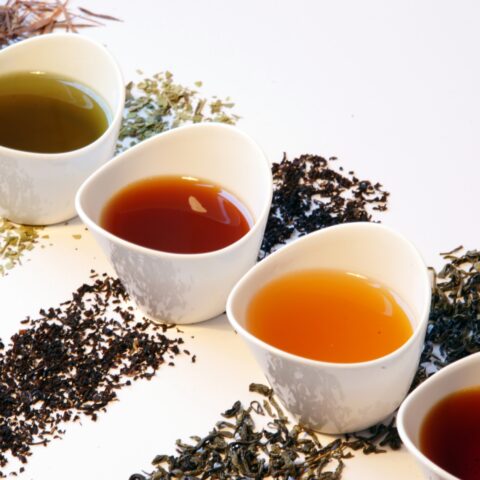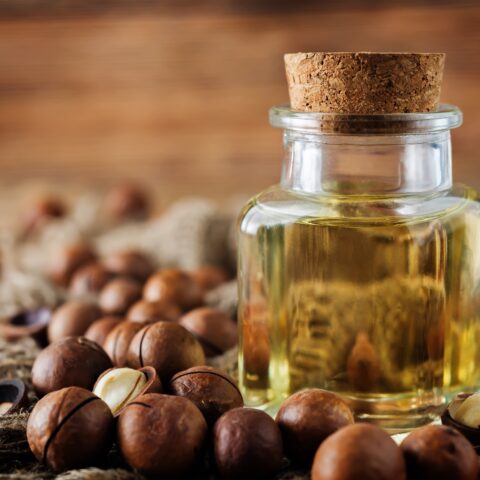Most Canned Sardines Are Bad for You. Here’s How to Choose Healthy Canned Sardines.

Sardines are small, oily fish well-known for their high levels of omega-3 fatty acids. But are they just as healthy when you get them canned vs. fresh?
Unfortunately, fresh sardines and canned sardines are not equal in nutritional value. Canned sardines are often packed in oil, water, mustard, tomato, or other sauces that can increase sodium levels.
Read on to learn more about why fresh sardines are better than canned, and how you can shop smarter for the canned variety.
Four Problems with Most Canned Sardines
Sardines are synonymous with those little tin cans they’re packed in, but sadly, these products are pretty far removed from the fresh variety. Here’s what you need to know.
1. Canned sardines are high in salt and low in potassium.
Sodium and potassium have a synergistic relationship, and it’s important to get more potassium to offset any sodium you consume. And while fresh sardines contain more potassium than sodium, canned sardines actually contain higher levels of sodium. [1]
You can read more about the dangers of a high salt diet here. And yes, “healthier” sea salt counts, too.
2. There are fewer vitamins and minerals in canned sardines.
The canning process requires sardines to be cooked at high temperatures – twice! As a result, canned sardines have much lower vitamin and mineral content compared to their fresh counterparts.
B vitamins in particular decline during the canning process. On average, canning reduces vitamin B1 by 75 %, vitamin B2 by 51 %, vitamin B3 by 34 %, vitamin B6 by 50 %, and vitamin B12 by 38 %. [1]
Other minerals suffer from this heating process, too. On average, magnesium in canned sardines is reduced by 44%, zinc by 36 %, and copper by 19% compared to fresh sardines. [1]
3. They’re packed in pro-inflammatory oils.
Since people are often looking to sardines as an anti-inflammatory food, it’s important to know that canned sardines are often packed in unhealthy oils that may negate the healthy oils.
Sardines are often packed in soybean or vegetable oils, which are heavy omega-6 fatty acids. These acids are inflammatory to the body when out of balance with omega-3s. [2]
According to a study published in the American Journal of Clinical Nutrition in 2000, soybean oil is made up of 51% omega-6 fatty acids and only 7% omega-3 fatty acids. That defeats the purpose of eating sardines to improve your omega-3 to omega-6 ratio! [3]
4. They may contain oxidized cholesterol.
Another downside of consuming canned sardines is the significant formation of oxidized cholesterol byproducts or cholesterol oxides. Scientists refer to them as “oxysterols.” Canned fish and seafood products are particularly susceptible to the formation of highly toxic cholesterol oxides that directly result from the retort cooking necessary to eliminate bacteria and botulism. [4, 5]
These oxysterols have several negative effects on human health, including atherosclerosis (causing coronary heart disease), neurodegenerative diseases, inflammatory bowel diseases, and age-related macular degeneration. [6, 7, 8, 9]
Fish and seafood products also contain high concentrations of long-chain omega-3 fatty acids docosahexaenoic acid (DHA) and eicosapentaenoic acid (EPA). These omega-3s have multiple beneficial health effects when consumed fresh. However, they are highly susceptible to thermal (heat) processing and as a result are significantly degraded in the canning process. [10]
How to Buy Healthier Canned Sardines
So, what can we do when canned sardines are so much more readily available (and affordable) than fresh?
Here are some tips for finding the healthiest canned sardines at the store.
1. Make sure they’re packed in spring water.
To limit your exposure to pro-inflammatory oils, look for sardines that are packed in spring water.
2. Check the label for added salt.
Some brands make it clear when there is no salt added. Buying sardines free of added salt is an easy way to avoid throwing off your sodium-potassium nutrient radio.
3. Rinse off excess salt.
If you can’t find a brand that has a “No Salt Added” version, look for sardines that are packed in spring water. Then, rinsing the sardines may help to reduce some of the salt content. Just empty the can into a colander and rinse with cold water, shaking it and turning the sardines as you rinse. Done.
4. Make sure the can is BPA-Free.
Another thing to look for whenever you’re shopping for canned food is in BPA-free packaging. BPA stands for Bisphenol-A. It’s often added to can linings to prevent corroding and to keep the food inside from taking on a metallic taste. Unfortunately, BPA may act as an endocrine disruptor, causing hormonal problems. It may also increase risk of inflammatory bowel diseases, like Crohn’s and ulcerative colitis. [11, 12] It’s best to avoid BPA whenever you can.
Canned Sardines Can Be Healthy If You Shop with Care
While fresh sardines are the better choice, we recognize that this choice isn’t always available. To get the most health benefits from your canned sardines, shop with care. Look for sardines packed in water, and if you can’t find a brand without any added salt, simply give them a good rinse. Do your best to seek out a brand that uses BPA-free cans. When you take these simple precautions, you can ensure that the canned sardines you buy are enhancing your health, and not working against it!
If you want a deeper dive into this topic, read the article; Fresh Sardines or Canned Sardines: No Longer an Option for Americans written by Dr. CordainTM!
References:
[1] FoodData Central – U.S. DEPARTMENT OF AGRICULTURE – Agricultural Research Service. https://fdc.nal.usda.gov//fdc-…;
[2] DiNicolantonio JJ, O’Keefe JH. Importance of maintaining a low omega-6/omega-3 ratio for reducing inflammation. Open Heart. 2018 Nov 26;5(2):e000946. doi: 10.1136/openhrt-2018-000946. PMID: 30564378; PMCID: PMC6269634. https://openheart.bmj.com/cont…;
[3] Kris-Etherton, P. M., Taylor, D. S., Yu-Poth, S., et al. (2000). Polyunsaturated fatty acids in the food chain in the United States. The American journal of clinical nutrition, 71(1 Suppl), 179S–88S.
[4] Dantas, N. M., Sampaio, G. R., Ferreira, F. S. et al. (2015). Cholesterol Oxidation in Fish and Fish Products. Journal of food science, 80(12), R2627–R2639.
[5] Otaegui-Arrazola, A., Menéndez-Carreño, M., Ansorena, D., & Astiasarán, I. (2010). Oxysterols: A world to explore. Food and chemical toxicology : an international journal published for the British Industrial Biological Research Association, 48(12), 3289–3303.
[6] Zarrouk, A., Vejux, A., Mackrill, J., O’Callaghan, Y., Hammami, M., O’Brien, N., & Lizard, G. (2014). Involvement of oxysterols in age-related diseases and ageing processes. Ageing research reviews, 18, 148–162.
[7] Kulig, W., Cwiklik, L., Jurkiewicz, P., Rog, T., & Vattulainen, I. (2016). Cholesterol oxidation products and their biological importance. Chemistry and physics of lipids, 199, 144–160. https://doi.org/10.1016/j.chem…;
[8] Vejux, A., & Lizard, G. (2009). Cytotoxic effects of oxysterols associated with human diseases: Induction of cell death (apoptosis and/or oncosis), oxidative and inflammatory activities, and phospholipidosis. Molecular aspects of medicine, 30(3), 153–170.
[9] Poli, G., Biasi, F., & Leonarduzzi, G. (2013). Oxysterols in the pathogenesis of major chronic diseases. Redox biology, 1(1), 125–130.
[10] Hădărugă DI, Ünlüsayin M, Gruia AT, Birău Mitroi C, Rusu G, Hădărugă NG. Thermal and oxidative stability of Atlantic salmon oil (Salmo salar L.) and complexation with β-cyclodextrin. Beilstein J Org Chem. 2016 Feb 2;12:179-91. doi: 10.3762/bjoc.12.20. PMID: 26977177; PMCID: PMC4778528. https://www.ncbi.nlm.nih.gov/p…;
[11] National Institute of Environmental Health Sciences. (2020, March 5). Bisphenol A.
[12] Texas A&M AgriLife Communications. (2018, July 5). BPA risk factor for inflammatory bowel disease. ScienceDaily.
Betsy Schroeder
Betsy does research and writing for a few different websites in the natural health field after taking Masters level courses in Nutrition & Functional Medicine through the University of Western States.
More About The Author




